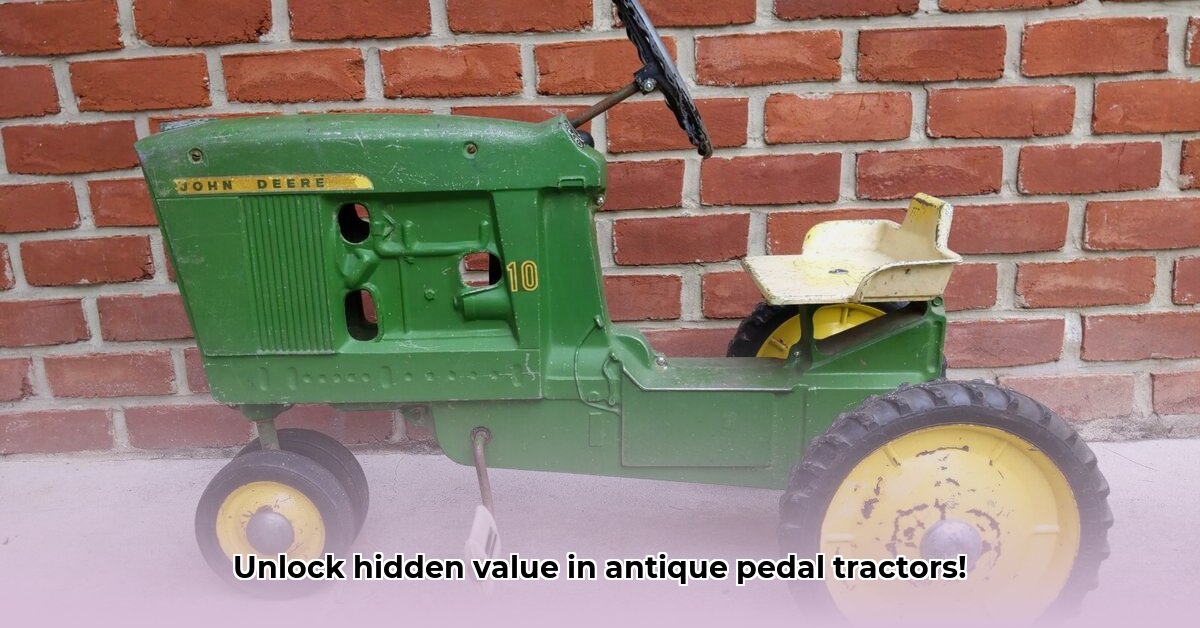
These charming miniature machines are more than just toys; they're captivating pieces of Americana, reflecting agricultural history and the evolution of toy manufacturing. This guide empowers you to navigate the world of antique pedal tractors, confidently identifying authentic treasures and assessing their value. For more on specific brands, check out this resource on vintage pedal tractors.
A Brief History of Pedal Tractor Collectibles
Imagine a simpler time when children's play mimicked the powerful machines working the land. This is the essence of the antique pedal tractor. Early models, often constructed from durable cast iron, reflect the materials and manufacturing techniques of their era. Companies like Eska and Ertl became prominent manufacturers, each contributing unique designs and manufacturing processes. Their tractors weren't simply playthings; they were miniature representations of the working machines integral to many lives. The evolution of their designs mirrors not only manufacturing advancements but also societal shifts in technology and play.
Identifying Authentic Antique Pedal Tractors
Discovering a potential treasure is exciting, but verifying authenticity is crucial. Even seasoned collectors can be misled, so proceed with caution!
Step 1: The Weight and Feel Test
Authentic mid-20th-century pedal tractors were typically made of cast iron – they're surprisingly heavy! A lightweight tractor is a major red flag; reproductions often employ lighter, cheaper materials like plastic or resin. Many cast iron tractors are magnetic; a non-magnetic tractor might suggest a different material and a potentially newer reproduction.
Step 2: Scrutinizing the Seams
Examine seams closely. Early, often hand-finished models exhibit uneven, rough seams. This contrasts sharply with the consistently smooth seams of modern, machine-cast reproductions. Think handmade pottery versus mass-produced china – the handmade artifact has inherent character.
Step 3: Paint Analysis
The paint provides valuable clues. Authentic tractors often display the effects of time—chips, fading, and perhaps amateur touch-ups. Brush strokes frequently indicate hand-painting, a hallmark of earlier methods. A flawless, smooth paint job might signal a newer copy.
Step 4: Precise Measurements
Even within a single model, slight size variations exist in vintage tractors. Compare your tractor's dimensions to verified originals using reputable online resources or books. Significant discrepancies raise suspicion.
Step 5: The Non-Magnetic Material Indicator
The presence of non-magnetic materials (like epoxy resin) often suggests repairs or reproduction components. While not automatically disqualifying a tractor, it necessitates close examination.
Authenticity Checklist:
| Feature | Authentic Vintage Tractor | Reproduction |
|---|---|---|
| Material | Primarily cast iron; heavy, magnetic | Lighter; may use plastic, resin, or other materials |
| Seams | Irregular, hand-finished | Smooth, machine-cast |
| Paint Application | Brush strokes, often chipped or faded | Even, spray-painted finish |
| Overall Finish | Imperfect; evidence of hand-polishing | Uniform, polished finish |
| Dimensions | Slight variations possible; use reference guides | Consistent; potentially slightly off from originals |
| Epoxy/Non-Magnetic Materials | Usually absent (except in repairs) | Often present |
Determining the Value of Your Antique Pedal Tractor
Valuing antique pedal tractors is complex; there's no magic formula. Several key factors influence price:
Condition: Pristine, well-maintained tractors command higher prices than damaged ones. Minor wear is expected, but significant damage diminishes value. Isn't it remarkable how a few scratches can significantly alter a tractor's worth?
Rarity: Less common models or those from lesser-known manufacturers often fetch higher prices. Limited-edition models or unique variations significantly increase value. Have you ever wondered why some rare tractors are so sought after?
Manufacturer: Established brands like Eska and Ertl generally command higher prices than less-known brands, all other factors equal.
Age: Older tractors, in good condition, tend to be more valuable. However, this is not an absolute rule.
Auction data offers insights into past sales, but these are snapshots, varying by time, location, and seller expertise. A centralized database is lacking, making precise valuation challenging. How can we accurately price these treasures when data is so scattered?
Resources and Further Research
Utilize diverse resources, combining online sources with collector forums and specialized books. Engaging with experienced collectors provides invaluable insights and helps avoid costly mistakes.
Protecting Yourself from Fraud
Online auctions and private sales pose risks. Always exercise caution and prioritize thorough checks before purchasing.
Thorough Inspection: Examine the tractor closely; take numerous high-resolution photos and videos.
Seek Expert Opinion: If possible, obtain a professional appraisal before buying.
Seller Research: Check online reviews and feedback. A history of positive transactions indicates trustworthiness.
Avoid Unsubstantiated Bargains: Be wary of unusually low prices—they can mask reproductions or scams.
Buying antique pedal tractors requires diligence and patience. Combine thorough research with a keen eye for detail to increase your chances of finding a genuine treasure.